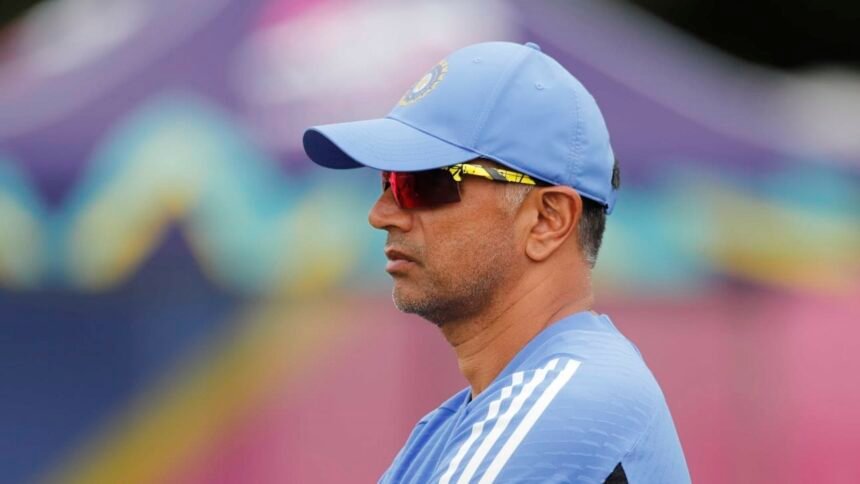As this India leadership group starts its last two weeks at the helm, it is a good time to look back. Their biggest legacy will be dragging India towards modern limited-overs batting. Look at its biggest manifestation: Virat Kohli is a much better T20 batter while retaining qualities that made him an ODI great. In India, though, legacy is judged by ICC trophies. That unfortunately remains the yardstick for a team now used to staying among the best at other times.
In what has been a bit of an irony, what seems like a last hurrah for Rahul Dravid and Rohit Sharma at helm and will eventually decide how fondly they are remembered by the wider public, their real legacy of pushing the aggression envelope has had to take a back seat. Two of their biggest hitters, their modern T20 batters, Suryakumar Yadav and Shivam Dube, have had to play like they would in the middle overs of an ODI.
“Like you rightly said, a lot of the impetus over the last few years – and I think we’ve done it in most parts – has been to push the needle forward,” Dravid said. “If you look at a lot of our stats and numbers, we have pushed the needle forward in terms of our batting.
“There’s no question about it. Sometimes in certain conditions – you’ve just got to be mindful of conditions also. I think sometimes we just get carried away in T20 cricket and just talking about pushing the needle forward, pushing the needle forward. But then, it’s also, cricket is a very condition-specific game. It’s one of the only sports left where the surface makes such an impact on the actual skill levels, the actual performance levels, what is an acceptable performance level. It’s one sport that we play where the surface makes a huge difference and it has to be brought into consideration at all times.
“I think we saw that in the US, and we saw that in New York, that had to be brought into consideration not only for us but for other teams as well. I think everyone had to do that. Actually, even in Australia [during the last T20 World Cup], there were times where you had to bring that into consideration. Not every wicket is Hyderabad or not every wicket can be the same. So, I think that’s something we pride ourselves in as well. I think we are trying to also get that ability to be smart in our decision making, to try and assess situations cleverly.”
If India get the kind of pitches they had in New York, they are favourites. In the Super Eight, though, they, like most other teams, will have to deal with the unpredictability of new conditions in every match in the West Indies, and quickly decide how to approach their innings. In cricket’s other formats, batting is a reactive exercise: the bowlers start the action, and batters react to the merit of the delivery. In T20, the batters’ approach plays a bigger role. And it all depends on conditions.
In a way, the previous two weeks of the T20 World Cup have been a bit of a lottery. You get put in, you take two extra overs to decide what a par score is, and you could be done for. That’s all it takes. That is likely what happened to Pakistan when they played USA. How do you mitigate the uncertainty, though? Dravid was asked exactly that a day before the start of India’s three Super Eight matches in five days in Barbados, Antigua and St Lucia.
“We feel we’ve got the experience and the knowledge and also the ability to counteract different situations that may present themselves,” he said. “And then, of course, we are looking at things that the past games that have been played here, what have been the scores, what’s the level of swing that people are experiencing, amount of turn they’re getting, what’s the bounce. So, you look at all of these factors and you come up with some basic ideas.
“But again, I think you’ve got to keep an open mind. I think that’s an important thing. You might have all the stats, you might have all the data, but on the day, sometimes conditions can be very different to what you think it is. Just because a particular ground has produced certain number of runs in the past or even 10 days prior, it can be very different because the preparation of a wicket, the weather, so much can change.
“Even in the two or three days leading into a particular game, a lot can change that can force you to recalibrate and rethink. I think we will have to do that, be quick and smart and be able to do that and assess the conditions. I hope we will do that.”
If New York was any indication, though, one change, though subtle, is clearly visible. India adjusted down instead of adjusting up. Err high rather than low. The top order, especially Kohli, showed enough faith in the batters to follow. It would have been easy for Kohli to play at a run a ball there but that is not his role. That seems to be the back-up option, and one for someone else to take. Nothing can guarantee success in T20 knockouts but that approach, provided they can manage to retain courage and indifference towards the end result, might just hold India in better stead than on previous attempts.
Sidharth Monga is a senior writer at ESPNcricinfo







